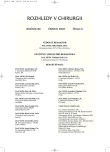Controversy in the Indication of Surgical Treatment of Acute Bleeding for Peptic Ulcers in Gastroduodenum
Authors:
P. Zonča 1; M. Lerch 1; K. Piš 1; A. Matušek 1; P. Kovala 2; M. Kremer 2; Z. Dostalík 2
Authors‘ workplace:
Chirurgické a traumatologické oddělení, MN Ostrava, primář: MUDr. Z. Dostalík
1; I. interní oddělení, MN Ostrava, primář: MUDr. K. Piš
2
Published in:
Rozhl. Chir., 2007, roč. 86, č. 6, s. 291-293.
Category:
Monothematic special - Original
Overview
Introduction:
Bleeding in the upper part of GI tract is a serious condition requiring careful investigation and adequate treatment. The surgical treatment is irreplaceable in the case of unsuccessful conservative treatments. The timing of a surgical intervention in diagnostic-therapeutic algorithm is still controversial, although there are a lot of identification factors.
Material:
538 patients with bleeding I and IIA according to Forrest classification were hospitalized in surgical ICU in the period from July 2001 till December 2006. There were 310 men and 228 women together.
Result:
34 patients with mortality 17.6% were surgically treated after unsuccessful conservative and endoscopic treatment.
Conclusion:
The early surgical intervention for patients with bleeding from peptic ulcus decreases its mortality. The emergency surgical intervention is necessary for patients when bleeding continues in an adequate conservative treatment or in the excessive recurrent bleeding. It is also necessary when the active bleeding is not endoscopicaly treatable or approachable. The number of emergency surgical interventions can be decreased by effective endoscopical treatment and by stabilization of patients. In the case of the location of bleeding in the back wall of duodenal bulbus or in the location of little curvature and especially in bigger peptical lesions the elective surgical intervention should be concerned because of the high risk of recurrence of bleeding. The mortality rate in emergency surgical intervention for excessive bleeding ranges from 10 till 50% compared with elective operations according to literature.
Key words:
indication – surgical treatment – bleeding – peptic ulcer
Sources
1. Blatchford, O., Davidson, L. A., Murray, W. R., Blatchford, M., Pell, J. Acute upper gastrointestinal haemorrhage in west of Scotland: čase ascertainment study. BMJ. 1997; 315 : 510–514. [PMID: 9329304]
2. Jiranek, G. C., Kozarek, R. A. A cost-effective approach to the patient with peptic ulcer bleeding. Surg. Clin. North Am., 1996;76 : 83–103. [PMID: 8629205]
3. Rockall, T. A., Logan, R. F. A., Devlin, H. B., et al. Incidence of and mortality from acute upper gastrointestinal haemorrhage in the United Kingdom. BMJ 1995; 311 : 222–226.
4. Ghosh, S., Watts, D., Kinnear, M. Management of gastrointestinal haemorrhage Postgrad. Med. J., 2002; 78 : 4–14.
5. Barkun, A., Bardou, M., Marshall, J. K. for the Nonvariceal Upper GI Bleeding Consensus Conference Group Consensus Recommendations for Managing Patients with Nonvariceal Upper Gastrointestinal Bleeding Annals of Internal Medicine Volume 139, Number 10.
6. Laine, L., Peterson, W. L. Bleeding peptic ulcer. N. Engl. J. Med., 1994; 331 : 717–727.
7. Krosen, A. J. Ulkuskrankheit – Notfalleingriffe, in Operationskurs Magenchirurgie, Buhr HJ, Runkel N., August, 2000, Barth Verlag, Heidelberg.
8. Forrest, J. A. H. Endoscopy in gastrointestinal bleeding. Lancet II, 394, 1974.
9. Siewert, J. R., Holscher, A. H., Buml, R. Chirurgische Terapie der gastroduodenalen Blutung. In: Siewert, J. R. Chirurgische Gastroenterologie. Springer New York Heidelberg Tokyo, 1993.
10. Rockall, T. A., Logan, R. F. A., Devlin, H. B., Northfield, T. C. Influencing the practice and outcome in acute upper gastrointestinal haemorrhage. Gut 1997, 41 : 606–611.
11. Vreeburg, E. M., Terwee, C. B., Snel, P., Raus, E. A. J., Bartelsman, J. F. W. M. vd Meulen, J. H. P., Tytgat, G. N. J. Validation of the Rockall risk scoring system in upper gastrointestinal bleeding. Gut, 1999, 44 : 331–335.
12. Lehnert, T., Herfarth, C. Peptic ulcer surgery in patients with liver cirrhosis. Ann. Surg., 1993, 217(4), 338–346.
13. Rockall, T. A. Management and outcome of patients undergoing surgery after acute upper gastrointestinal haemorrhage. J. R. Soc. Med., 1998, 91 : 518–523.
14. Wei, K. L., Tung, S. Y., Sheen, C. H., Chany, T. S., Lee, I. L., Wu, C. S. Effect of oral esomeprazole on recurrrent bleeding after endoscopic treatment of bleeding peptic ulcers. J. Gastroenterol. Hepatol., 2007, Jan, 22(1): 43–46.
15. Schonberg, M. H., Birk, D., Beckh, K., Stange, E. F., Frohneiser, E., Adler, G., Beger, H. G. Endoskopische und chirurgische Terapie Blutung der ulcera duodeni et ventriculi. 1995, Chirurg, 66, 326.
16. Reuben, B. C., Neumayer, L. A. Variations reported in surgical practice for bleeding duodenal ulcers. Am. J. Surg., 2006, Nov, 192(5): 42–45.
17. Sakra, L., Rajman, M., Havlicek, K., Vyhnalek, P. Surgical trastment of upper gastrointestinal hemorrhagie of peptic ulcer origin non treatable by endoskopy. Rozhl. Chir., 2001, Jun, 80(6): 324–328.
18. Vokurka, J., Wechsler, J., Zak, J., Vlček, P., Capot, I. Endo-scopic and surgical treatment of acute bleeding gastroduodenal ulcers. Bratisl. Lek. Listy, 1997 Mar, 98(3): 163–165.
19. Sakra, L., Havlicek, K., Vyhnalek, P. Surgical therapy options for bleeding gastroduodenal peptic lesions. Rozhl. Chir., 2004, Jul, 83(7): 314–319.
Labels
Surgery Orthopaedics Trauma surgeryArticle was published in
Perspectives in Surgery

2007 Issue 6
Most read in this issue
- Laparoscopic Management of Epidermoid Spleen Cyst
- Complications of the Laparoscopic Appendectomy
- Pyogenic Abscesses of the Liver
- Disorder of Vertebral Metastasis
